Dealing with Time Series Data — Pandas’ parse_dates Explained
Pandas, a powerful data analysis library in Python, offers various functions to handle datetime data efficiently. One such function is…
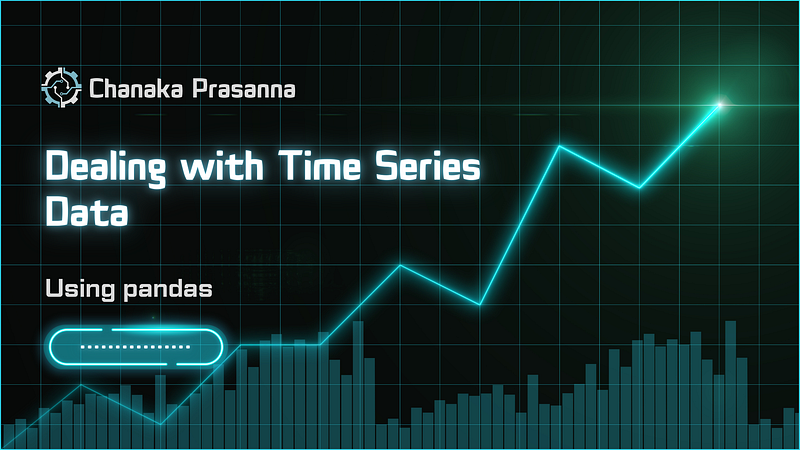
Pandas, a powerful data analysis library in Python, offers various functions to handle datetime data efficiently. One such function is parse_dates, which plays a crucial role in managing date and time information within datasets.
1. What is parse_dates?
The parse_dates function in pandas is used during data loading to automatically recognize and parse datetime strings into datetime objects. When reading data from a CSV or other file formats, pandas can detect columns containing datetime information and convert them into a datetime data type for easier manipulation and analysis.
2. Why is parse_dates Needed?
Handling datetime data accurately is essential in data analysis and modeling. By using parse_dates, pandas ensures that date columns are correctly interpreted as datetime objects, allowing for chronological sorting, time-based aggregations, and meaningful visualizations. This function simplifies the process of working with dates, especially when dealing with large datasets spanning different time periods.
3. Problems if We Don’t Use parse_dates
If parse_dates is not utilized during data loading, date columns are treated as strings or generic objects by default. This can lead to several issues including,
- Incorrect Sorting — Dates may not sort chronologically, affecting time-series analyses.
- Limited Functionality — Date-related functions like date arithmetic and date-based filtering won’t work correctly.
- Performance Impact — Manual parsing of dates using loops or functions can be slower and less efficient than pandas’ optimized methods.
4. Pros of Using parse_dates
When parse_dates is employed,
- Automatic Conversion — Dates are automatically converted to datetime objects, simplifying operations like date arithmetic and filtering.
- Improved Accuracy — Ensures accurate handling of date formats, preventing errors in data analysis and visualization.
- Enhanced Functionality — Enables seamless integration with pandas’ datetime functionalities, such as resampling, time shifting, and period calculations.
Let’s see a code example.
Github link to the notebook and the dataset — https://github.com/Chanaka-Prasanna/Datasets/tree/main/parse_dates_in_pandas
To demonstrate the parse_dates functionality,I considered a hypothetical dataset containing the SalePrice and Date attributes of bulldozers. For simplicity in this demonstration, we assume that the SalePrice is determined solely by the Date attribute.# Import necessary tools
import pandas as pd
import matplotlib.pyplot as pltHere I imported pandas since it contains parse_dates function . And matplotlib to draw charts.
# Import datset as a dataframe
df = pd.read_csv('data.csv',low_memory=False)
df.head()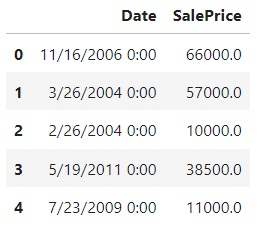
df.info()Here you can see initially the type of Date column is object.
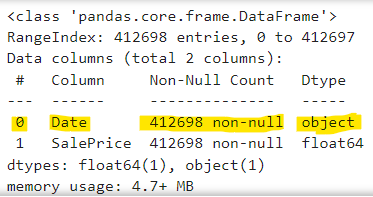
fig, ax = plt.subplots()
ax.scatter(df["Date"][:1000],df["SalePrice"][:1000])Now we are plotting data without using parse_dates (First 1000 records only).
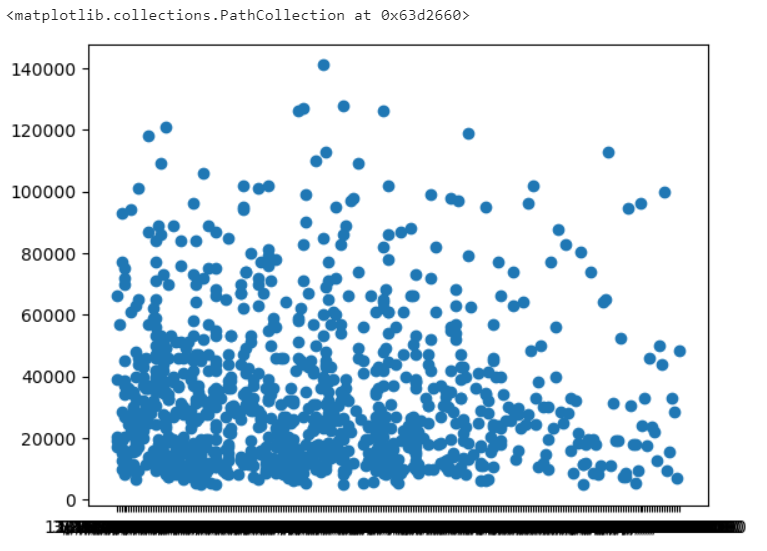
You can see what happened to the X-axis. If the Date column is not parsed as dates, the x-axis will show a cluttered array of string values, making it difficult to interpret. Instead of a clean, chronological axis, you'll see individual string entries, which can appear as a jumbled mess of values. This occurs because matplotlib treats the strings as categorical data rather than continuous datetime data, leading to an axis crowded with every unique string value.
To see this clearly, let’s consider the first 10 records only.
fig, ax = plt.subplots()
ax.scatter(df["Date"][:10],df["SalePrice"][:10])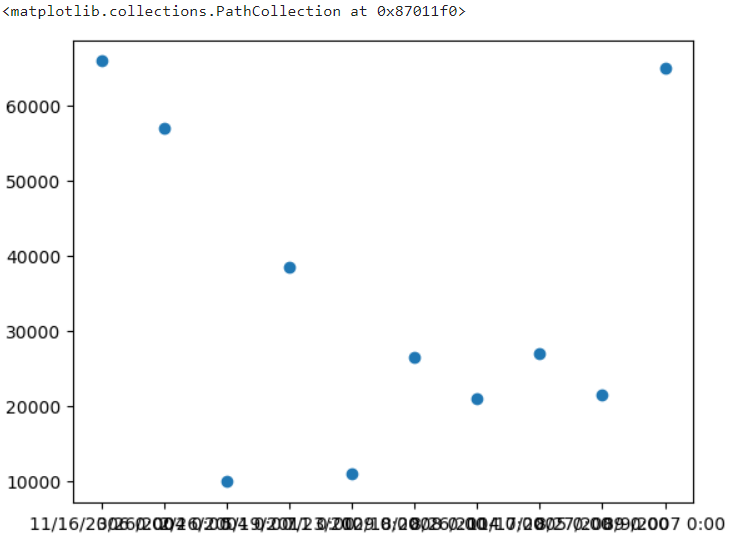
As a solution, we can use parse_dates feature from Pandas Library.
df_test = pd.read_csv('data.csv',low_memory=False,parse_dates=['Date'])
df_test.info()
You can see, now the type of Date is datetime64[ns]
What is datetime64[ns]?
datetime64: This indicates that the data type is a datetime object, specifically designed to handle date and time information.[ns]: This stands for nanoseconds, indicating the precision of the datetime values.
Let’s plot the data now…(First 1000 records only)
fig, ax = plt.subplots()
ax.scatter(df_test["Date"][:1000],df_test["SalePrice"][:1000])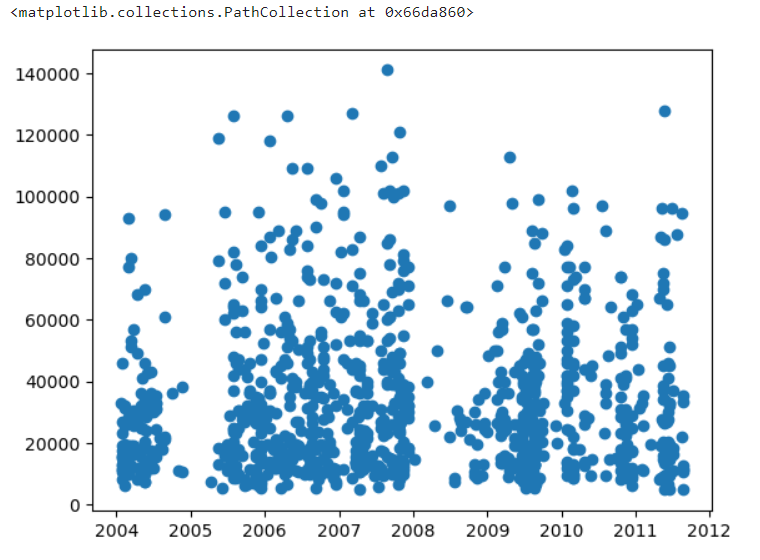
Alright, now you can see some differences in the graph (Figure 1 and Figure 3). Changes in the dot pattern and the X-axis labels
When parse_dates=['Date'] is used while reading the CSV, the changes you will see in the graph and the x-axis are,
- X-axis - The x-axis will display the dates chronologically, treating them as continuous datetime objects.
- Graph Clarity - The dates will be accurately spaced according to their actual intervals, making the trend over time more clear and interpretable.
Without parse_dates, the x-axis would show a cluttered array of string values, making it hard to interpret the time-based trends.
Let’s play with data
# Extracting features
df_test['Year'] = df_test['Date'].dt.year
df_test['Month'] = df_test['Date'].dt.month
df_test['Day'] = df_test['Date'].dt.day
df_test['DayOfWeek'] = df_test['Date'].dt.dayofweek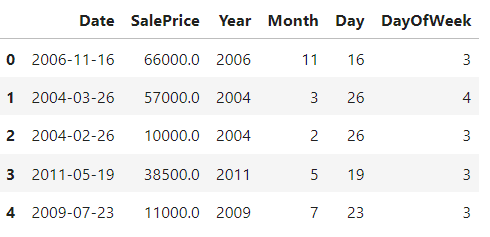
You can extract lots of features than mentioned above. See the documentation for more details.
If you try to extract these features without converting dates into datetime objects, you will face this error.
# Extracting features
df['Year'] = df['Date'].dt.year
df['Month'] = df['Date'].dt.month
df['Day'] = dt['Date'].dt.day
df['DayOfWeek'] = df['Date'].dt.dayofweek
df.head()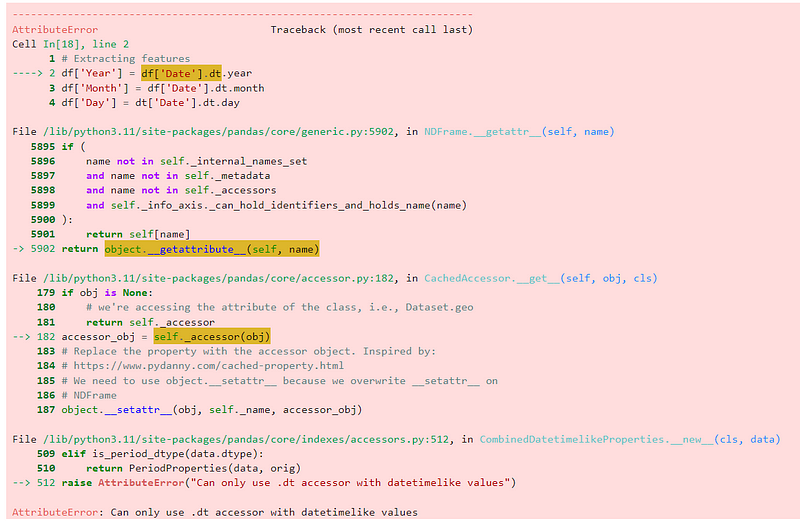
That means you can’t extract these features without converting dates into datetime objects. You may have some inefficient ways like loops to do so. But Those ways are not recommended.
Using the parse_dates function in pandas is crucial for effectively managing datetime data. It automatically converts date strings into datetime objects, enabling accurate and efficient date-based operations. Without it, dates are treated as strings, leading to sorting issues, limited functionality, and reduced performance. By employing parse_dates, we ensure our data analysis is more accurate and our visualizations are clearer, making it a vital tool for anyone working with date and time data in pandas.
Pandas, a powerful data analysis library in Python, offers various functions to handle datetime data efficiently. One such function is parse_dates, which plays a crucial role in managing date and time information within datasets.
If you found this useful, follow me for future articles. It motivates me to write more for you.
Follow me on Medium
Follow me on LinkedIn

